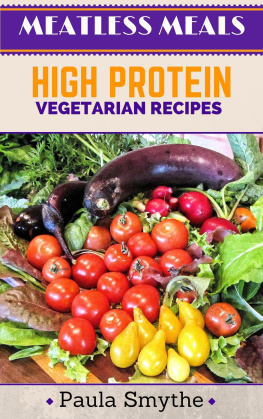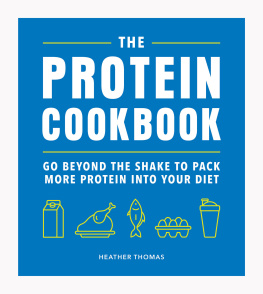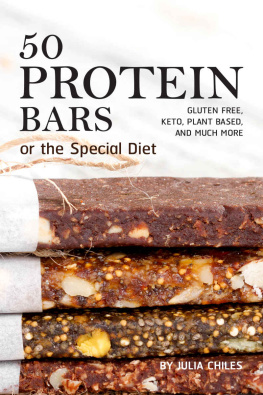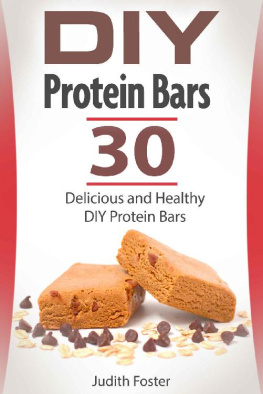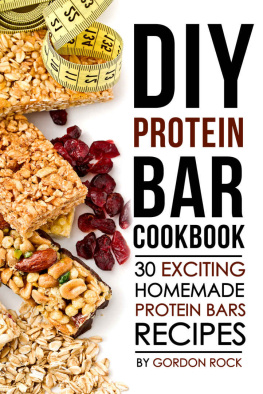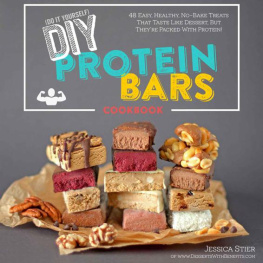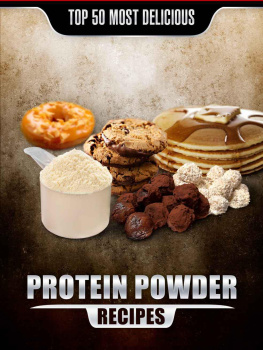ALSO BY ANNA SWARD
The Ultimate Protein Powder Cookbook

TO ZOE:
The Absolute Love of My Life

CONTENTS

Making your own healthy protein-based snacks is extremely quick and easy. Its the kind of thing that, once you try, you find yourself doing every week, sometimes even every day. Ive been making my own protein foodsbars, truffles, pancakes, cakes, pizzas... you name itfor over ten years now. I started off like most people do: with protein shakes. I was in college, regularly running and training at the gym several times a week, so I bought a tub of protein to fortify my diet. I did exactly what the label told me: I added two scoops to a shaker with water, shook it, and downed it. Before long, though, I got bored. I mean, dont get me wrong, a protein shake is nice every now and then. Its basically a nutritious milkshake and who doesnt love milkshakes, right? But I got bored with them quickly and, alongside my boredom, there was something else I didnt like: the fact that I was drinking a bunch of protein and calories in a matter of minutes (sometimes seconds!) and that was it. And Id rather eat than drink my calories. Its more fun that way, you know? More satisfying. So I stopped drinking shakes and, instead, started adding protein to my oatmeal. I started making cookies with it. I started making cakes, pizza, bread, muffins, even donuts! The more I used protein powder in my foods, alongside other nutrition-dense ingredientssuch as fruits, veggies, nuts, and seedsthe more I realized that using protein powder as an ingredient in snacks and healthy meals was a revolution waiting to happen.
I started doing all this back in 2010, back when protein powderbased recipes only existed in obscure bodybuilding forums that contained low-res food photos that looked as if they came straight out of a horror filmyou know, gray foods, amorphous cakes, shiny abominations that didnt look appetizing in the slightest. It was either that or the recipes showed no photos at all. You had no idea what you were getting into. On the Internet back then, there was very little guidance, help, or advice on how to cook with protein powders. Traditional chefs rejected them, viewing protein powders in general as fake food. Foodies werent touching protein powders of any kind either. Most people simply didnt regard or approach protein powders as they would food. They saw them as muscle-building supplements, not as something they could or would want to cook with. Plant-based protein powders were especially foreign to most people. When they were released into the mainstream market, around 2010, nothing was being written about using, let alone cooking with, veggie protein powders at all. No one knew what to do with them. To the vast majority of people, protein powder equaled whey protein, and whey protein equaled shakes. Thats where the conversation began and ended. So when veggie protein powders came out, people had no idea what to expect. The ones who tried them, immediately approached them as they would wheytheyd throw a scoop in their blender and POW! Expect a shake. But they were quickly disappointed because, unlike whey protein, plant-based protein powders dont really yield thick and milkshakey shakestheyre more savory, thicker, and far less creamy. As a result, most people cast veggie protein powders aside.
So I taught myself. I went through a lot of trial and error to better understand how to cook not just with whey protein, but with all the other protein powders that slowly emerged as the years went by. I became a mad scientist of sorts, turning my kitchen upside down every time I got back from the gym, feeding my family all sorts of experiments. And I learned a lot! I learned that protein powder should never be treated as white flour and that you should never substitute whey protein with a plant-based protein. I learned that, for best results, you should try to make sure your batter is made up of less than 30 percent whey protein when baking, otherwise your food will end up hard and rubbery. I learned how to read ingredient labels and that, as alluring as flavored and pre-sweetened proteins can be, unflavored products give you the freedom to flavor and sweeten your foods however you like. I learned that protein powder is not a muscle-growing magic potionits just food, like eggs are just food, like chicken.
Through proteinpow.com, I journaled my protein-cooking experiments over the years and built a global community of followers whose excitement and engagement began to cause a ripple effect. Thanks to our burgeoning community, the popularity of our Protein Pow app, and the rise of my previous cookbook, The Ultimate Protein Powder Cookbook, we played a major role in turning cooking with protein powder into a movement, that, today, transcends borders and unites people worldwide. We grabbed it from the shadows and thrust it into the limelight so that, today, if you go to any healthy-eating caf or restaurant, youll probably find protein pancakes or protein energy balls on their menu.
Today, using protein powder has gone mainstream. If you open any fitness and nutrition book or magazine, chances are high youll run into a protein powderbased recipe. Your favorite celebrities? Yeah, most of them use protein powders every day. So do athletes, as do many busy professionals, moms, dads, and even grandparents across the world. If you Google or search for protein recipes or #ProteinRecipes on Facebook or Instagram, youll find hundreds of thousands of posts; posts from people all over the world who, instead of using their protein powders for shakes, have chosen to make delicious foods with them. Theyre posts from people from all walks of life who choose to think outside the shake! After reading this book, I bet youll be joining in the ranks too, hashtagging #ProteinRecipes and #ProteinPow with gustosharing your recipes, snacks, and journeys through this oh-so-exciting brand-new world of protein POW! Because why have a shake when you can have cake?


Protein is a key nutrient and is essential to our health. It comprises amino acidsour bodys building blocksand it repairs, maintains, and builds muscle and connective tissue. Besides water, protein is the most abundant organic compound in our body: its found in our hair, skin, muscle, and connective tissue. Every part of our body is made up of protein. Without protein, we wouldnt be able to function! Wed experience weakness, fatigue, hair loss, muscle loss, and eventually... wed give up the ghost.
You can find varying amounts of protein in meat, fish, chicken, dairy, pulses, and beans. Many fruits and vegetables contain protein too, but only in small amounts. This means that, in the course of your daily food intake, you consume protein. But do you consume enough? And, more important, do you pay attention to where that protein comes from, and what else you are getting alongside protein in your food?
Next page

